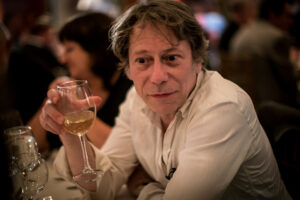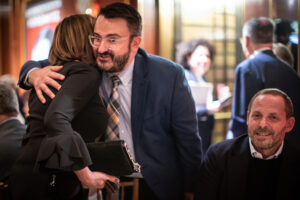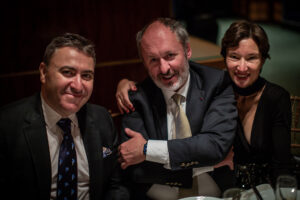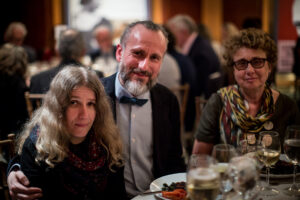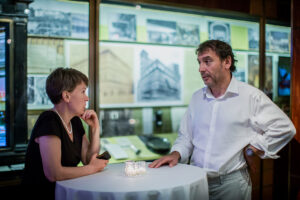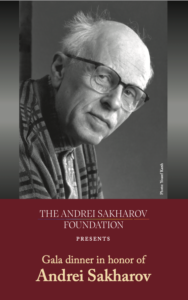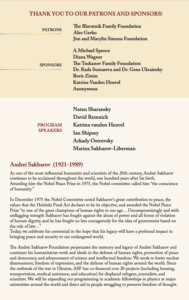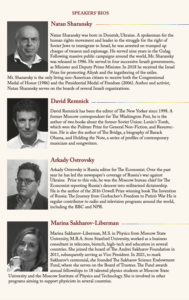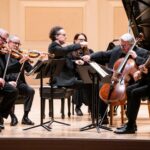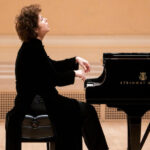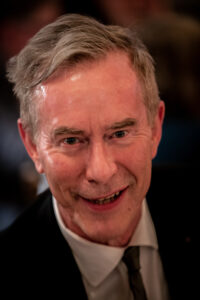 Head of the Department of Physics, Oxford University, professor Ian Shipsey delivered an exciting overview of the achievements of Andrei Sakharov and the enduring impact of his theoretical works on many physics fields today
Head of the Department of Physics, Oxford University, professor Ian Shipsey delivered an exciting overview of the achievements of Andrei Sakharov and the enduring impact of his theoretical works on many physics fields todayAndrei Sakahrov, talented and versatile scientist, fearless activist and staunch proponent of human rights, was described in the citation for his 1975 Nobel Peace Prize as “spokesperson for the conscience of mankind.
Sakharov was born in 1921 into a family with the traditions of the Russian intelligentsia. His father a well-known physics teacher, early schooling at home, high school, then in 1938 he enrolled in the Moscow University Physics Department.
In October 1941, the German army approaching, the university transferred to Ashkhabad, in Turkmenistan, where Sakharov graduated in 1942 and gained his first vivid impression of the life of workers and peasants during that difficult summer.
Sakharov's fellow students recollect his remarkable abilities to think, formulate and resolve science problems. And that he was the only one who, in that time of deprivation and hunger, would give his own last piece of bread to someone who badly needed it.
After university, Sakharov worked for three years as an engineer at an arms factory where he developed inventions to improve the plant's inspection procedures.
His scientific research began at the Lebedev Institute in 1945 under Tamm an eminent physicist and 1958 Nobel Laureate. Sakharov’s first paper at 26 was on the production of subatomic particles in the cosmic rays that rain down on us from outer space. His thesis in 1947 was on transitions in nuclear physics.
In 1948, Sakharov was enlisted in classified work on atomic weapons, in Tamm's group. Sakharov was one of the creators of the Soviet atomic bomb and is often referred to as "the father of the Soviet hydrogen bomb”.
Andrei came to prominence with his contributions to thermonuclear fusion with Tamm. including the idea to contain a plasma (a highly excited state of matter found for example in the center of the sun) in a magnetic bottle - the tokamak. The Tokamak paper was declassified by the Soviet Academy on the eve of the 1958 Geneva Conference on Peaceful Applications of Atomic Energy. Today the tokamak is the foundation of one of the two main paths of research toward self-sustaining nuclear fusion which, by mimicking the sun’s conversion of hydrogen into helium has the promise to provide almost unlimited green energy thereby offering one of several possible solutions to climate change. For his fusion work Sakharov became an Academician in 1953 at 32 - at that time the youngest ever to be so honored.
Sakharov published no scientific research papers between 1958 and 1965 a period when he grew increasingly concerned about the accelerating course of the arms race and the dangers of radioactive fallout from continued testing of nuclear weapons in the atmosphere. He published an analysis of the harmful consequences of radioactive pollution in 1959 and was actively involved in initiatives in the Soviet Union leading to the Limited Test Ban Treaty of 1963.
In 1965 Sakharov entered a new field: cosmology. His third publication is one of the boldest and most famous physics papers of the 20th century. Its aim: to explain why the matter in the universe is built of protons, neutrons and electrons, while antiprotons, antineutrons and positrons are so rare that we can only observe antimatter when produced in high-energy collisions, mainly in particle accelerators such as at CERN and Fermilab. The particle-antiparticle disparity is referred to as the "matter anti-matter asymmetry of the universe". This disparity is not academic when matter and anti-matter meet they annihilate producing light. It they were of equal abundance they would have long since annihilated each other and there would be no matter and no us. Sakharov made the elegant assumption that originally the universe had no matter anti-matter asymmetry. He then showed an asymmetry required three things first that the asymmetry would build via out of equilibrium processes during the expansion of the early universe, second the proton must be unstable, and third processes violating particle antiparticle symmetry must be at play. These are known today as Sakharovs’ three conditions1.
Features of Sakharov’s visionary theoretical ideas became characteristic of later theoretical models. The quest to discover proton decay is the goal of a worldwide program of exquisitely sensitive large-scale underground particle physics experiments, and Sakharov provided the motivation and inspiration for generations of particle physicists including myself to seek and study matter-antimatter asymmetry in a global program. Despite tremendous progress recognized with the 1980 and 2008 Nobel Prizes, matter antimatter asymmetry remains one of the greatest mysteries of particle physics.
In 1968, Sakharov published in the West his first "non-physics" paper — his remarkable "Reflections on Progress, Peaceful Coexistence and Intellectual Freedom." He develops two basic themes: That the division of mankind threatens it with destruction, and that intellectual freedom is vital to human society. Sakharov repeated these two themes for the rest of his life.
Sakahrov was not able to receive the Nobel Peace Prize in person. From 1980, during his exile in Gorki, he valiantly remained in touch with developments in science, receiving physics literature by registered mail. He continued to study the asymmetry of the universe until the end of his life his last physics paper and last physics talk were on the topic.
Sakharov's cosmological views were an important part of him.. At the end of his Nobel Lecture he writes: “Like a gleam in the darkness, we have appeared for an instant from the black nothingness of the ever-unconscious matter, in order to make good the demands of Reason and create a life worthy of ourselves and of the Goal we only dimly perceive”.
In a message entitled “the responsibility of scientists’ to a 1981 New York meeting held in his honor he wrote ‘scientists are not only better informed than the average person but also strive for and enjoy more freedom. Freedom, however, entails responsibility’. With steadfast ideals and indomitable courage Andre Sakahrov never ever shirked this duty.
Andrei Sakahrov was brave, he was admired, respected, trusted and loved. He was a wise council, a compelling call to action and to accountability, the conscience of humankind, a heroic figure. But not only was he these things he is these things and more. In a very real sense he is with us today in this room and beyond it. Only the unloved die for love is immortality.
1 For the physicists: the Sakharov Conditions are a set of three necessary conditions that a baryon-generating interaction must satisfy to produce matter and antimatter at different rates. These conditions were inspired by the then recent discoveries of the cosmic background radiation and CP-violation in the kaon system. (1) Baryon number violation; (2) C-symmetry and CP-symmetry violation; and (3) Interactions out of thermal equilibrium. Baryon number violation is a necessary condition to produce an excess of baryons over anti-baryons. But C-symmetry violation is also needed so that the interactions which produce more baryons than anti-baryons will not be counterbalanced by interactions which produce more anti-baryons than baryons. CP-symmetry violation is required because otherwise equal numbers of left-handed baryons and right-handed anti-baryons would be produced, as well as equal numbers of left-handed anti-baryons and right-handed baryons. Finally, the interactions must be out of thermal equilibrium, since otherwise CPT symmetry would assure compensation between processes increasing and decreasing the baryon number. This footnote based on: https://en.wikipedia.org/wiki/Baryogenesis.
 Katrina vanden Heuvel speaking at the gala in honor of Andrei Sakharov
Katrina vanden Heuvel speaking at the gala in honor of Andrei SakharovSomeone once said that history is to a nation what memory is to an individual.
Or as the Russian writer Yuri Trifonov wrote,” history is not simply something that was. history is with us and in us.”
Today we mark the anniversary of a great man. As darkness and repression envelope Russia, forgetting Sakharov’s humane legacy is a step backward — and it must be resisted.
Andrei Sakharov’s journey from a Soviet nuclear physicist, one of the premier creators of the country’s thermonuclear bomb, to its key anti-nuclear dissident, fused with his decency, and fearless truthtelling, made Sakharov a moral compass. Not simply the conscience of Russia; but a citizen of the world.
Sakharov understood the true consequences of the use of nuclear weapons and the senselessness of the arms race. He was unique.
Yet there was someone else who understood the perils of nuclear weapons -- Mikhail Gorbachev.
My late husband Stephen Cohen and I had a deep admiration for Mikhail Sergeevich, both as an individual and as a leader who used his power so courageously to change his country and the world.
I believe he was the most radical thinker about security to ever lead a nuclear country. As President, he reversed generations of military buildup and democratized his country to help put an end to the Cold War. And of course, his legacy will be measured by bringing Andrei Sakharov and his wife, Yelena Bonner, back to Moscow from exile in Gorky — in 1986.
In 1989, Sakharov was elected to the Congress of People’s Deputies where he spoke boldly in support of radical changes and democratic reforms. He and Gorbachev sparred — as millions watched on television — yet there was a genuine respect between the two men. After all, the two Nobel Prize winners understood that fundamentally, human security is best achieved through cooperation, democratization and demilitarization.
I would echo a principle repeated many times by Gorbachev — "if we don’t attempt what seems impossible, we will risk facing the unthinkable.”
More than three decades later, after Gorbachev attended Sakharov’s funeral (in 1989) — he stood humbly at the foot of his coffin — and then Gorbachev's passing last August (2022), there is little if anything left of the historic opportunities Sakharov and Gorbachev opened up for their country and the world. There remains, however, the hope that as sometimes happens in history, the memory of lost alternatives will one day inspire efforts to regain them and that will require a new generation here, there to show the decency, idealism and political skills.


